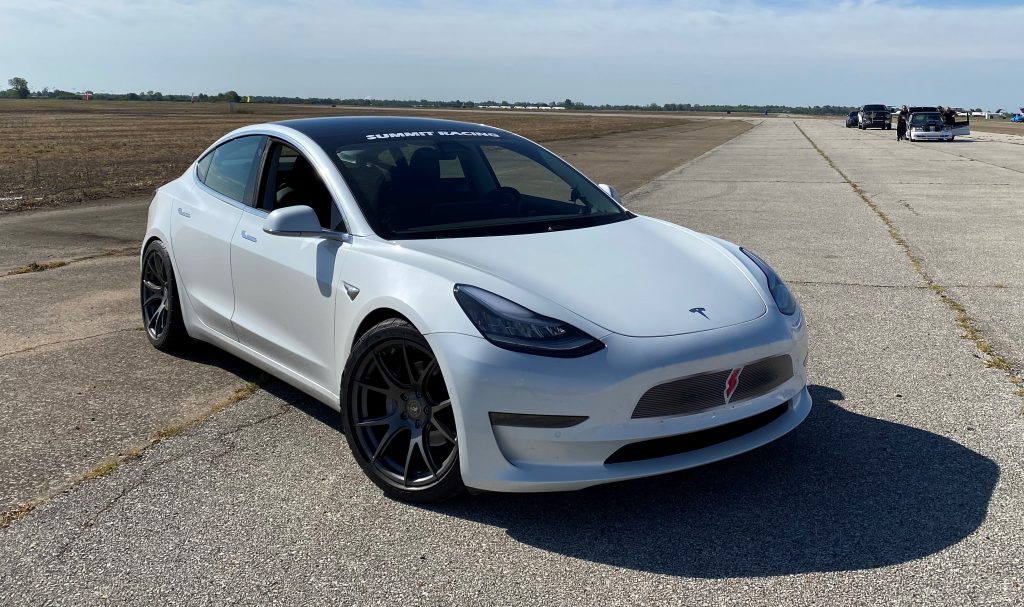
Whether it’s gas, diesel, or electric, Summit Racing’s going to find a way to hot rod every vehicle it gets its hands on.
So we weren’t surprised when their tech folks told us about Project White Lightning. It’s a 340 kilowatt Dual Motor Tesla Model 3 Performance that’s going to be gradually transformed into a track toy, complete with some smart tire, brake, and suspension upgrades—without giving up an inch of daily drivability.
Over the course of the next few months, we’ll document White Lightning’s transformation to give you an idea of what these new electric vehicles can do in the proper performance-minded hands.
But first things first, the Summit Racing team needed to establish a performance baseline, so they took it to a local autocross course. With that, we’ll turn this article over to Summit Racing’s Brian Nutter.
***
White Lightning’s First Autocross
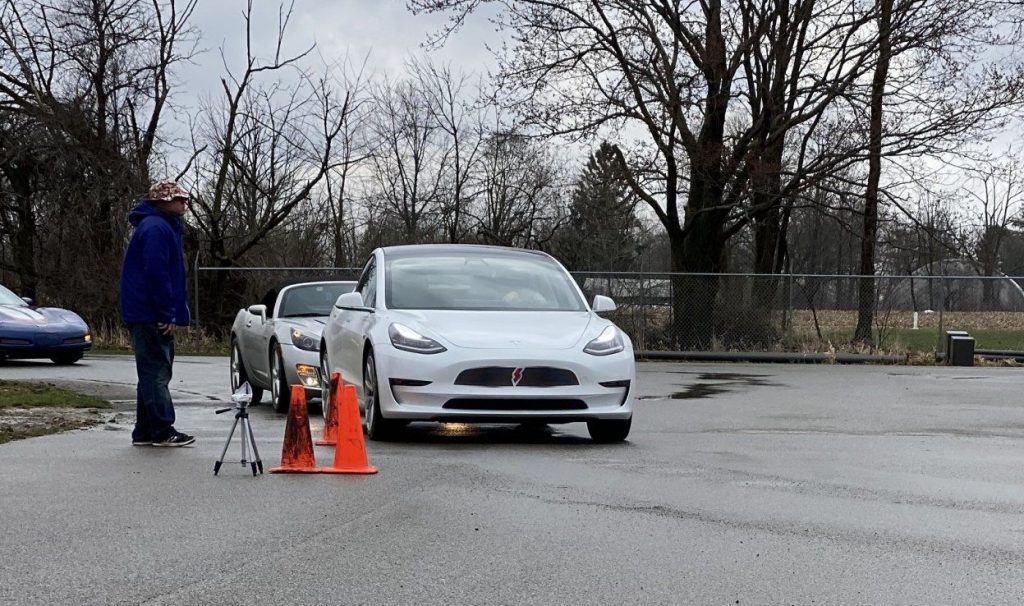
The Akron Sports Car Club had their first Autocross test and tune in early April at the Dragway 42 Drag Strip. The course was set up on side-access roads, which allowed for some relatively high speeds. Our primary goal was to get a feel for the car and determine how many runs we could get in. It was windy, raining, and in the low 40s when we arrived.
And there’s mud. Lots of it. We soon learned that going off-track backwards at 70 mph isn’t nearly as bad as having to clean the car up afterwards. (Removing the Tesla’s muddy underside aero panels is no fun.)
Our Plans for the Tesla Model 3’s Performance Baseline
I’d be taking White Lightning’s wheel, along with Summit Racing’s Chief Marketing Officer, Al Noe. Both of us have logged plenty of track time at autocross courses and drag strips. We also brought a Z51-equipped C8 Corvette with us for comparison.
We arrived with 206 miles of range and decided we could run it down to 100 before heading home, about 45 minutes away.
We initially set the car in track mode custom settings and dropped air pressure in the stock Continentals from 41 to 35 psi. Torque split started at 30/70 and ended up at 45/55 on the slick surface. The initial runs were all done with 100% Regen and we dialed that out by the end of the day.
Running the Course
The starting line leads to a hard left followed by a 150-foot chute into a slalom. Most cars couldn’t apply much power here due to puddles and cold tires.
Not so with the Tesla: Steer left. Full Throttle. GO!
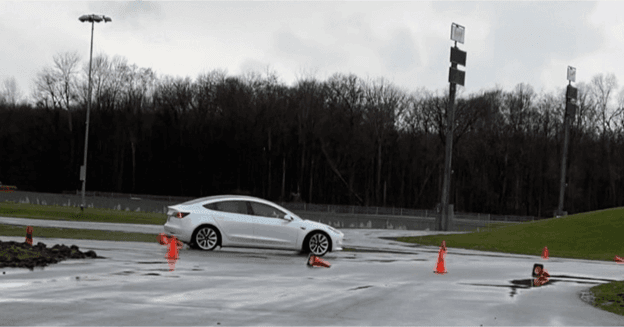
The Tesla slid out evenly, necessitating a quick dip of the throttle to get the car squared toward the left of the first slalom cone. This enabled the largest radius into a right bend at the end of the slalom. This was followed up by a 100 foot to a left and 100 feet to the right, followed by another 90 degree right on a short shoot. The car was picking up a lot of speed (70+ mph) and the road is wide, so we let the car push to the outside before apexing a right-hand cone followed by a quick left.
This is entirely too easy to mess up by going in hot. Which we did.
The Tesla’s brakes at 100% Regen go hard and the car did not stop as it should. Best runs were accomplished with Regen turned off. The conventional brakes get hot quickly due to the weight—but at least they’re consistent and have feel.
First area of improvement? Brake Pads! And as long as we’re making a wish list, bigger brakes.
There was another slalom that bends right, but cone spacing was equal (not always the case with diabolical course designers). Near the end was a fast 70-degree left for 100 feet followed by an 80-degree right into a wide straight toward the finish line. The Model 3 was hitting 70+ mph through the finish beams.
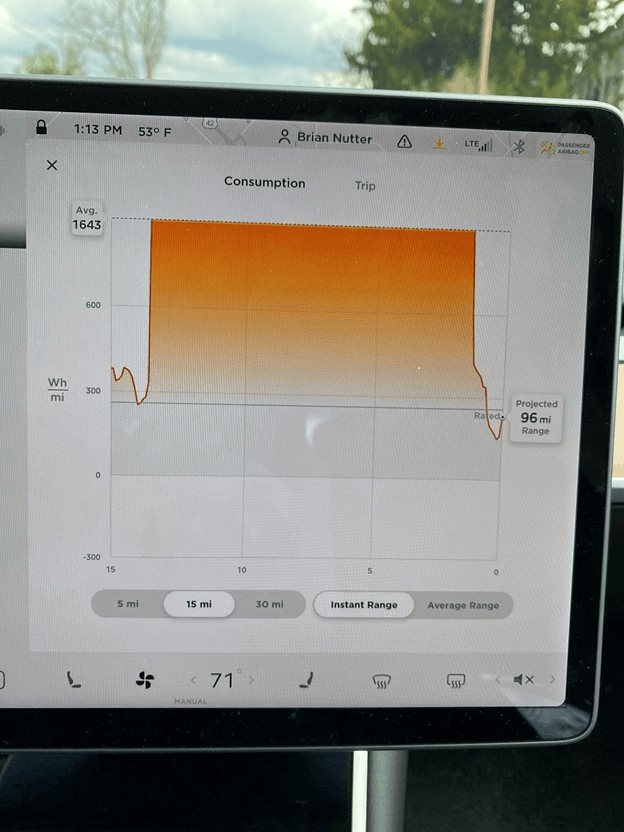
Tesla Model 3 Initial Autocross Performance
So how did White Lightning do?
Range: We were able to get in about 10 runs between both drivers. Mileage dropped from 205 to 101, so roughly 10 miles of range were used up per run. We would have loved more. As you can see, we aren’t afraid of WOT!
Driving Impressions: It handled fairly well, and the linear power was helpful. It was wet and there was mud on the track from other autocrossers leaving the course. If we gave the Tesla a bad input mid-apex, it would lose the back end and slide. The Model 3 would seemingly stop and gather itself up before rocketing to the next corner. This was not surprising given the rearward weight bias and a 235 “square” tire setup on all four corners. The tires are average but rolling over on the sidewall a bit. As we mentioned earlier, brake pads and eventually bigger brakes will be a big help. Be on the lookout for future articles on these performance upgrades.

The Tesla Model 3 Performance Results & Overall Reception
We got a lot of interest in the Tesla. It made going fast look a little too easy. No noise, not a lot of drama. Although it’s not our goal, it will probably hurt some feelings when we run it in the Super Street class.
More than one person said “well…I guess that’s the future.”
As for performance comparisons, the University of Akron’s Formula SAE cars were making high 50 second runs in the rain. In the earlier part of the morning, well-driven rear wheel drive cars were dropping into the 68/69 second range. There was a well-driven STI with autoX setup that dropped into the high 60.xxx range. A lowered Taurus SHO was also able to put power down and was running in the high 64 second range.
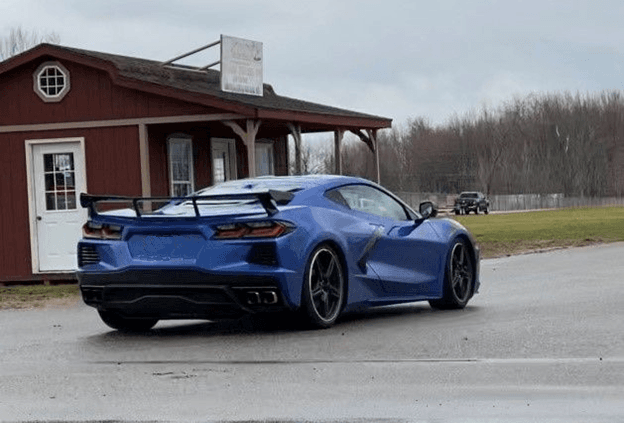
Both Al and I logged 60.3 second runs, but high winds were causing problems with the timing equipment. The last run of the day was around noon and it was warming up. Although the track was still damp, the Tesla dropped into the high 59 second range.
The Tesla was amazingly quick in the morning rain and damp conditions before we left; it is surprising how well the car puts power down even in less than optimal conditions. We told a few folks “it is really point and shoot”. From corner to corner the Tesla is a silent bullet!
Our friend Eric Heller, President of the Akron Sports Car Club, drove his C5 Z06 to a mid-55 second run later in the dry, and other competitors were also notably quicker as things began to dry out. So no FTD for our Tesla. Yet.
Initial Impressions of the Tesla Model 3’s Performance
Our first outing went well and we arrived at home base with 25 miles of range left. We found quite a few areas of improvement and are eager to share our findings with you. We have several events planned over the course of the summer, so stick with us. As we make our modifications, we’ll package them as “how tos,” complete with installation videos.

[…] when Summit Racing introduced us to White Lightning a while back, we knew the performance modifications to its Tesla Model 3 would start […]
[…] when Summit Racing introduced us to White Lightning a while back, we knew the performance modifications to its Tesla Model 3 would start […]
[…] when Summit Racing introduced us to White Lightning a while back, we knew the performance modifications to its Tesla Model 3 would start […]